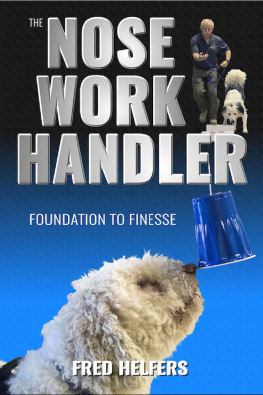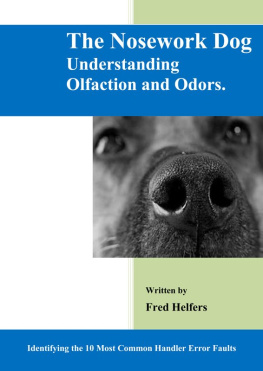Fred Helfers - The Nose Work Handler: Foundation to Finesse
Here you can read online Fred Helfers - The Nose Work Handler: Foundation to Finesse full text of the book (entire story) in english for free. Download pdf and epub, get meaning, cover and reviews about this ebook. year: 2017, publisher: Dogwise Publishing, genre: Home and family. Description of the work, (preface) as well as reviews are available. Best literature library LitArk.com created for fans of good reading and offers a wide selection of genres:
Romance novel
Science fiction
Adventure
Detective
Science
History
Home and family
Prose
Art
Politics
Computer
Non-fiction
Religion
Business
Children
Humor
Choose a favorite category and find really read worthwhile books. Enjoy immersion in the world of imagination, feel the emotions of the characters or learn something new for yourself, make an fascinating discovery.
- Book:The Nose Work Handler: Foundation to Finesse
- Author:
- Publisher:Dogwise Publishing
- Genre:
- Year:2017
- Rating:5 / 5
- Favourites:Add to favourites
- Your mark:
- 100
- 1
- 2
- 3
- 4
- 5
The Nose Work Handler: Foundation to Finesse: summary, description and annotation
We offer to read an annotation, description, summary or preface (depends on what the author of the book "The Nose Work Handler: Foundation to Finesse" wrote himself). If you haven't found the necessary information about the book — write in the comments, we will try to find it.
This comprehensive book takes you, the handler, from the basics through challenging advanced exercises. Color photographs and helpful diagrams, plus step-by-step instructions, walk you through the basics, coach you on improving your skills, and help you to work through errors and challenges.
The Nose Work Handler: Foundation to Finesse — read online for free the complete book (whole text) full work
Below is the text of the book, divided by pages. System saving the place of the last page read, allows you to conveniently read the book "The Nose Work Handler: Foundation to Finesse" online for free, without having to search again every time where you left off. Put a bookmark, and you can go to the page where you finished reading at any time.
Font size:
Interval:
Bookmark:
The Nose Work
Handler:
Foundation to
Finesse
Fred Helfers
2017 by Fred Helfers. All rights reserved, including the right to reproduce this book or portions thereof in any form whatsoever.
For information, address Fred Helfers at helfers@arczip.com .
K9 Nose Work, Barn Hunt, Q-tips, Solo cups, and other products mentioned in this book are trademarks, service marks, and/or registered trademarks of their respective owners.
Jacket photographs by Sue Town of Pinnicle Photography Jacket design by Cate Bramble
ISBN 978-0-996-1899-2-7
Permissions
Images in Figures by Sue Town of Pinnicle Photography.
Figures by Lee Titus, Thin Blue Line K9 LLC.
Figures by Craven, Brent A., Eric G. Paterson, Gary S. Settles, and Michael J. Lawson.
To the detection dogs in my life:
Sammy, Corky, Lexi, Casey, and Jillie.
I strive to honor the lessons each taught me.
Dr. Ken Furton Florida International University. For introducing me to the science of canine olfaction, and his continued support and encouragement.
Ron Gaunt Cofounder of the National Association of Canine Scent Work (NACSW). For 30 years of friendship and for introducing me to the wonderful world of K9 Nose Work.
Lee Titus U.S. Customs (retired), Thin Blue Line K9 LLC.
Rudy Schimscha Dog trainer for the Central Customs Authority of the Federal Republic of Germany. For sharing his wisdom and support during my early years in training detection dogs.
I worked as a narcotics detective on investigations and handled drug dogs for more than 20 years. On one occasion, one of my partners was undercover buying large quantities of heroin from a known dealer. After the sale, our narcotics unit would continue surveillance of the drug dealer for future intelligence before making an arrest.
We observed that after drug deliveries the dealer regularly stopped at an out of the way, largely unused park and ride lot next to a nature preserve near the dealers home. The dealer routinely walked into the nature preserve, stayed a few minutes, walked out, and drove home. We suspected that the drug dealer was using the nature preserve to hide drugs or money from the sale of drugs.
After the last drug delivery, the dealer did not stop at the park and ride he went straight home. We were curious about what might be hidden in the brush. I decided to use Corky, my four-legged partner, to determine whether a hidden stash existed.
I knew from training and experience that the environment would dictate the type of application (search technique) to use with Corky. It was early December in the Pacific Northwest, around 8 PM, lightly raining, and around 40 F in other words, it was cold, damp, and dark. Corky would need to get close to the source to detect any drug odor.
The nature preserve was an open area with several trails, probably 40 yards (36.5 meters) wide by 80 yards (73 meters) long. Tall grass and maple trees were surrounded by thick blackberry bushes which concealed the nature preserve from the road.
I positioned my human partners on the perimeter for officer safety. I put Corky on a 15-foot (4-meter) line, and started downwind. Working a coal-black Labrador Retriever in the dark was a challenge. I couldnt use a flashlight because it would diminish our night vision and reveal our location. After approximately 15 minutes of Corky dragging me through blackberry bushes and under and over fallen trees, we approached a small stand of maple trees.
Corky was working hard, air-scenting into the light breeze. After showing no interest at the first maple tree, Corky approached the second. Just as she passed the tree Corky snapped her head to the side and buried her nose in the leaves that covered the ground.
The next thing I knew Corky was pelting me with leaves and dirt from her digging. Her change of behavior was so dramatic it surprised me, but her behavior was consistent with her training as an active-alert drug dog. That is, Corky was trained to dig at a source of odor.
I quickly pulled Corky away for her own safety. I didnt know if she had located drugs, the remains of a dead animal, or trash. I handed the leash to one of my partners and inspected the hole.
I should have trusted my dog! Approximately 18 inches (457 millimeters) underground I found a white plastic shopping bag. The bag contained more than half a kilo (more than a pound) of heroin.
My partners were amazed that Corky found the buried drugs and wanted to know how this was possible.
Several thoughts went through my mind. I suspected the dealer had recently disturbed the location. The soil was very loosely compacted, which would allow for odor molecules to readily work their way to the surface. The ground was covered with large maple leaves which worked like a blanket to trap the earths heat and the odor molecules of the buried heroin. As Corky rapidly walked she was kicking up the fallen leaves and exposing the trapped odor.
Corkys find was the talk of the police department for days, and made me even more proud of my four-legged partner.
And now, science is beginning to understand the power of a dogs nose.
Chapter 1.
UNDERSTANDING OLFACTION AND ODOR
The focus in training detection dog teams is usually the dog. In reality, it is just as important to train handlers to become efficient, effective partners of dogs. During my three decades working with and training detection dogs and their handlers, its apparent to me that people who want to excel at training and handling detection dogs must understand a dogs sense of smell.
Why Dogs Have Noses
Authors Pearsall and Verbruggen in their book Scent: Training to Track, Search and Rescue identify the following functions performed by the dog olfactory system.
Sense organ. The nose is responsible for the sense of smell in a dog.
Airway. The nose is part of the dogs respiratory (breathing) system.
Air conditioner. Brings fresh air through and into the dogs respiratory system to help cool the dog.
Filter. Helps to prevent impurities and foreign objects from entering the nasal cavity.
Origin of reflexes such as sneezing. Expels foreign objects during sneezing.
Resonator or sound chamber. Amplifies communication (barking and whining).
The last function identified by Pearsall and Verbruggen and probably the most important function, if we are to understand how dogs detect odors is the use of the nose as a direction finder. The nasal cavity is divided by the septum into sides. Each side can detect minute variations in the strength and intensity of odor molecules. The source of odor molecules can be determined by these variations in strength and intensity.
Scent and Smell
What is scent?
Dictionaries describe scent as odor molecules that emanate from a substance or source and that affect the sense of smell. William Syrotuck in his marvelous book Scent and the Scenting Dog describes scent as being a combination of odors. He then defines odor as relating to a specific thing or object.
Throughout this book, when I use the word odor , I mean odor molecules that are emanating or coming from a specific source.
What is smell?
A smell is a perception by the sense of olfaction mediated by the olfactory nerve. Everything that you and a dog can perceive by olfaction emits molecules.
In general, molecules that can be smelled are:
Lightweight (move in the air)
Volatile (evaporate easily)
Soluble (are broken down by moisture)
The Canine Olfactory System
Moisture and heat must be present for smelling ( olfaction ) to occur. Think of olfaction as an equation: olfaction = moisture + heat.
Odor molecules enter the nose and travel through the nasal passageway. As the air moves it is filtered, warmed, and humidified. Specialized receptor cells use cilia (hairlike projections) to capture odor molecules, as you see in Figure 1. The olfactory cilia send a signal to the olfactory lobe of the brain where odor is recognized, interpreted, and stored.
Next pageFont size:
Interval:
Bookmark:
Similar books «The Nose Work Handler: Foundation to Finesse»
Look at similar books to The Nose Work Handler: Foundation to Finesse. We have selected literature similar in name and meaning in the hope of providing readers with more options to find new, interesting, not yet read works.
Discussion, reviews of the book The Nose Work Handler: Foundation to Finesse and just readers' own opinions. Leave your comments, write what you think about the work, its meaning or the main characters. Specify what exactly you liked and what you didn't like, and why you think so.





